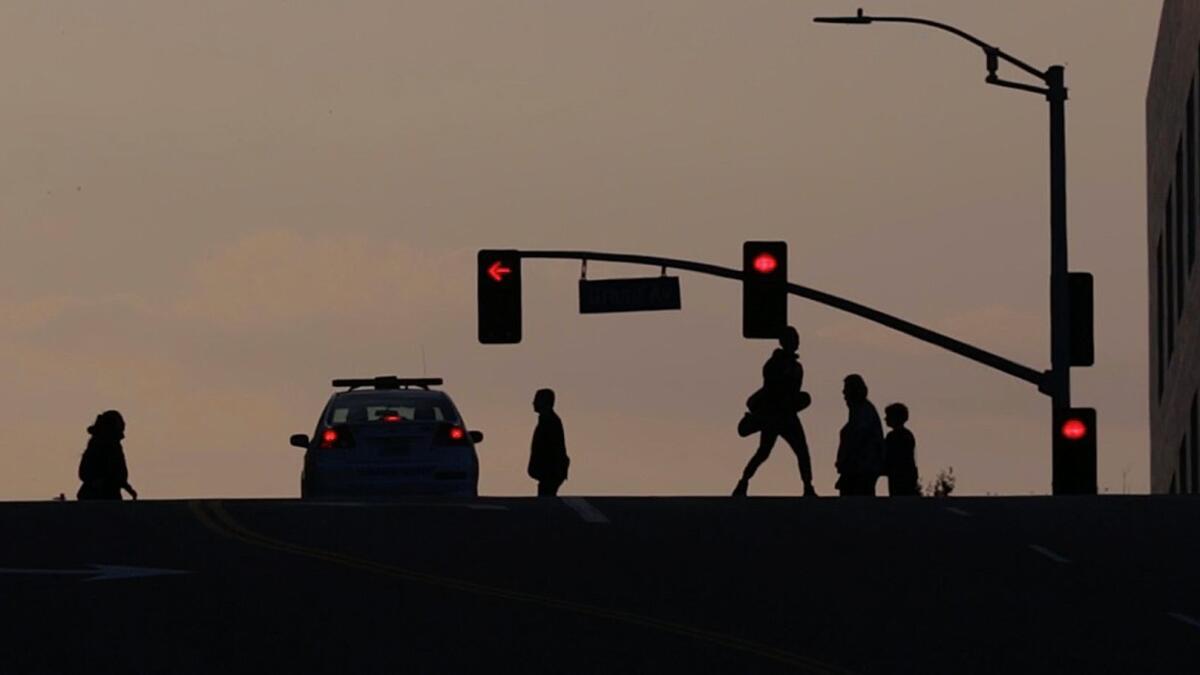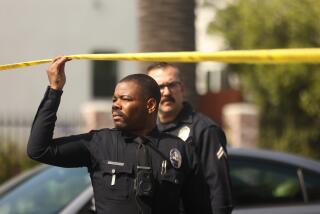Pedestrian deaths in L.A. rise sharply but officials remain committed to traffic safety program

Pedestrian deaths rose sharply in Los Angeles in 2017, but the disappointing figures do not mean the city should change course on an ambitious program to eliminate traffic fatalities, transportation officials said Wednesday.
During the second full year of the Vision Zero initiative, aimed at eliminating traffic deaths on city streets by 2025, the number of pedestrians killed on city streets rose 17% over the previous year, and 82% since 2015.
Overall, Los Angeles lowered traffic deaths by 3% last year. Officials had said the reduction was 6%; the figure changed Wednesday after state officials revised the number of deaths in 2016 to 254 from 260.
Mayor Eric Garcetti’s 2015 executive order that created Vision Zero called for a 20% reduction in deaths by 2017. The 3% reduction last year falls far short of that, prompting criticisms that the initiative is failing.
“That’s certainly not how I look at it,” Westside Councilman Mike Bonin said at a Wednesday meeting of the City Council’s transportation committee. “We need to be doing more Vision Zero.”
Though deaths and serious injuries rose 6% citywide last year, city officials said similar casualties fell 2% on the 450 miles of streets where two-thirds of pedestrian deaths occur.
Transportation officials focused on improvements along those corridors, adding concrete medians, more visible crosswalks, signs alerting drivers to pedestrians at mid-block crossings, and plastic reflectors and posts designed to slow drivers down as they turn right.
Many of the changes were installed last summer and fall. Typically, cities wait for one to two full years of data before gauging their success, Vision Zero division manager Nat Gale said.
The city also saw a decrease in deaths involving cyclists, drunk driving and hit-and-run crashes, the Los Angeles Police Department said.
Transportation officials say they will spend more money in 2018 on a campaign to remind Angelenos of the impact of unsafe driving.
The LAPD will also be able to write more speeding tickets along high-injury streets, Garcetti said at a news conference Wednesday.
State law requires that cities keep current traffic studies on streets with speed limits higher than 25 mph. If the surveys expire — and many had, along L.A.’s thousands of miles of streets — police officers cannot use laser or radar enforcement to write tickets until the studies are updated.
Citations play an important role in reminding people to drive safely, officials said.
With updated speed surveys, the LAPD wrote 27% more speeding tickets last year and plans to actively enforce speed limits along high-injury streets with an additional $1.5 million in funding for overtime shifts this fiscal year.
Garcetti urged drivers, pedestrians and cyclists to pay attention, follow traffic laws and put down their cellphones as they move through the city. He also asked drivers to slow down.
“I’ll say this to drivers in Los Angeles,” Garcetti said. “You do not want to be responsible for someone’s death.”
During a City Council committee meeting Wednesday, Councilman Paul Koretz — who represents a district that includes Sherman Oaks and Brentwood — questioned how the city can try to keep traffic flowing at rates of 35 to 40 mph and still save lives when those speeds are often fatal on impact.
“How do we keep those two conflicting goals from conflicting?” Koretz asked.
The goal is not to permanently reduce traffic speeds across the city, but to design streets so drivers have more warning and more awareness of pedestrians and cyclists, Transportation Department chief engineer Dan Mitchell said.
The goal, Mitchell said, is to give drivers “the time to react and slow down and stop, hopefully before a collision happens — but if it does happen, it happens at a very low speed.”
Twitter: @laura_nelson
More to Read
Sign up for Essential California
The most important California stories and recommendations in your inbox every morning.
You may occasionally receive promotional content from the Los Angeles Times.










